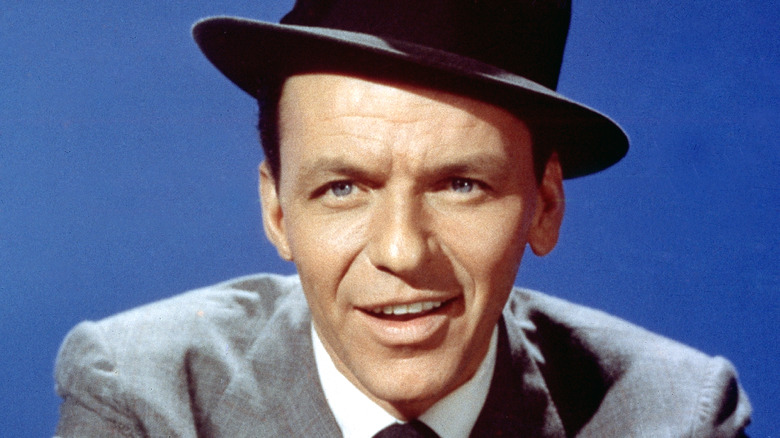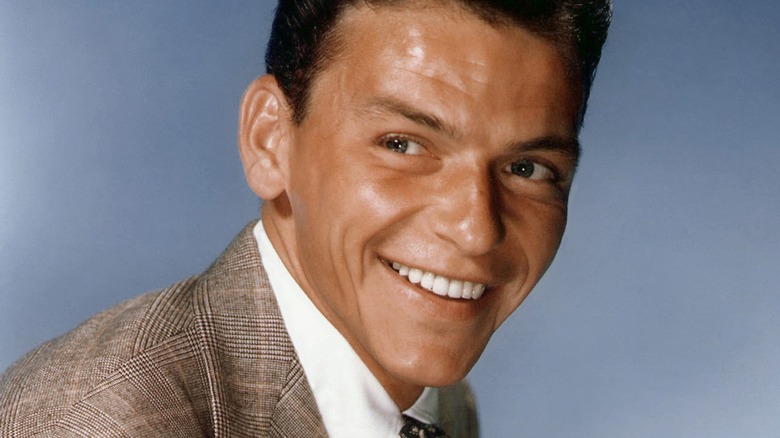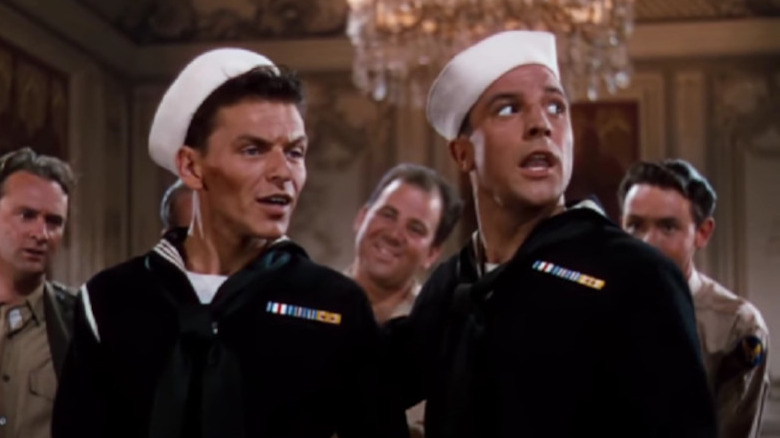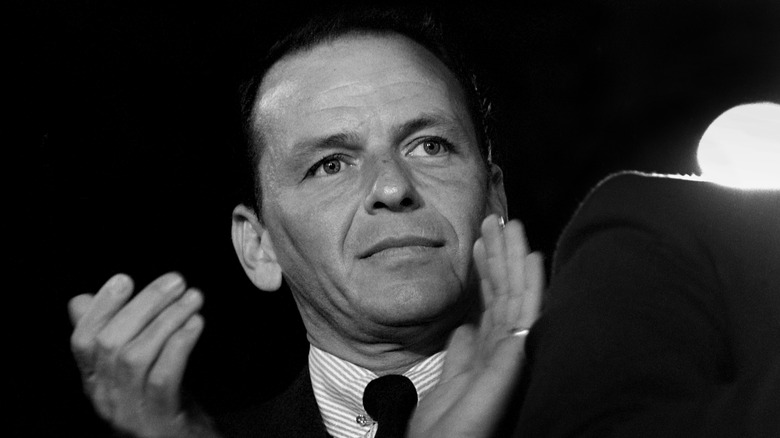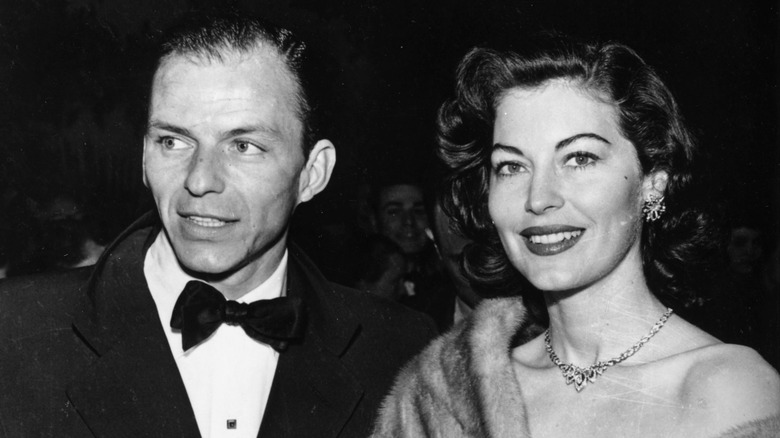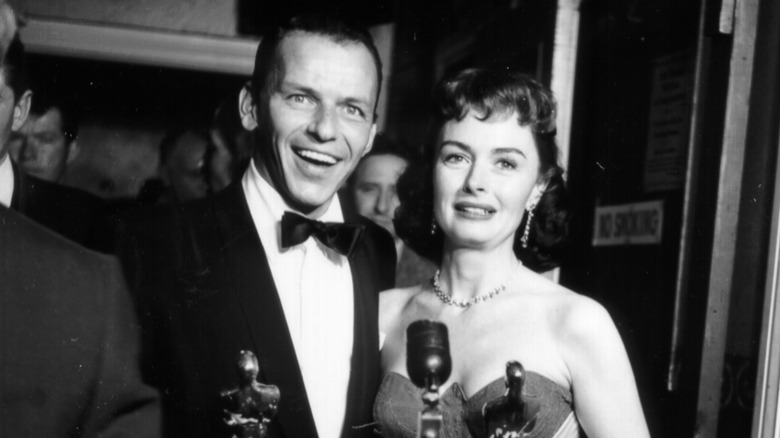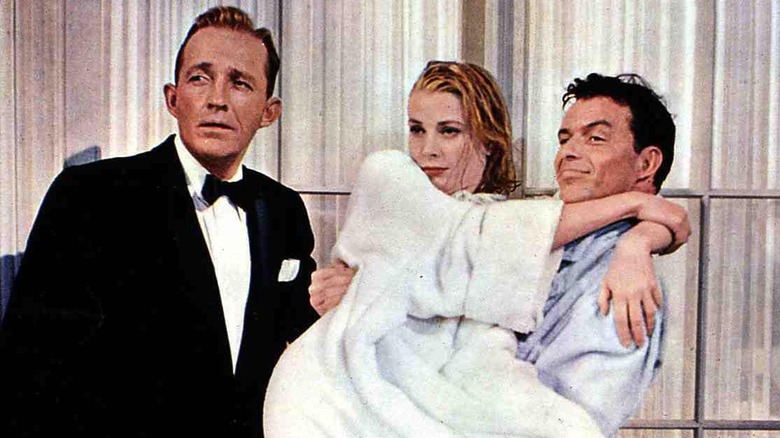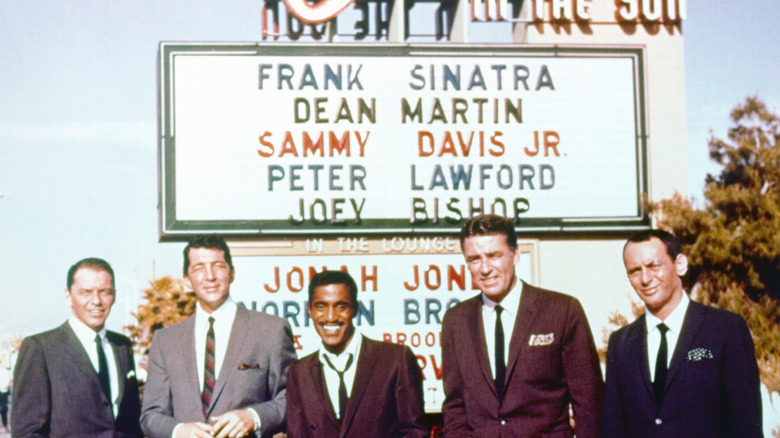The Evolution Of Frank Sinatra's Movie Career
Frank Sinatra is well known for his music, but his time in Hollywood proved that he was more than just a voice. When examining his acting roles, there are two distinct personas. The first is the shy guy who plays second fiddle to the likes of Gene Kelly, and the second is the suave boss he's remembered as in popular culture. What you might not know about Ol' Blue Eyes is that the reinvention of his image was born out of hardship.
The son of a tavern owner/prizefighter father and a local politician mother, Sinatra was confident and focused from a young age. After getting hooked on Bing Crosby as a teenager, he set his sights on becoming a singer. He joined a group called the Hoboken Four, winning some local competitions. Sinatra would ultimately get discovered while waiting tables in New Jersey — he was snapped up by trumpeter Harry James, who was looking for new band members.
This new opportunity would prove to be a mere stepping stone for Sinatra, who blew up almost overnight after going solo. Before long he was appearing in feature films, though he went through a rough patch in the 1950s, one that he almost didn't recover from. Let's take a look at how his film career evolved over the years.
He cut his teeth on cameo roles
Launching a solo career wasn't exactly straightforward for Frank Sinatra. After his fortuitous meeting with Harry James, he forged a working relationship with Tommy Dorsey, performing as a member of his group. Dorsey was reportedly angry when he found out that Sinatra planned to strike out on his own, and some difficult conversations followed. Some sources say that Dorsey wanted a third of everything Sinatra made as a solo performer. Ultimately, there was nothing Dorsey could do to slow down the young singer's meteoric rise.
Sinatra's solo career began in 1942, and the bobbysoxers fell in love with him instantly. He was a teenage heartthrob by the time he started his film career. At first, he was simply a specialty singer or played himself instead of having an actual part. Things expanded a bit for him in 1943's "Higher and Higher." Although he still played himself, Sinatra was part of the plot, interacting with the main characters and getting many lines in addition to his songs. The film capitalized on his talents and his appeal as a heartthrob, and before long he was being cast in musicals as genuine, non-cameo characters.
He struggled to keep up with Gene Kelly at first
When Frank Sinatra's film career took off, he often appeared as the shy guy who knew nothing about women. He got paired with the more experienced Gene Kelly in three films: "Anchors Aweigh" (1945), "Take Me Out to the Ball Game" (1949), and "On the Town" (1949). The two bounce off each other well and provide flip sides of masculinity. Kelly is the strong and confident ladies' man who takes Sinatra's eager pupil under his wing.
Kelly is definitely the stronger dancer, but you can see that Sinatra improves a great deal after "Anchors Aweigh." In the "I Begged Her" number in "Anchors Aweigh," it's clear that he's struggling to keep up and constantly watching Kelly's feet. This fixation is gone in the next two films. He is a more confident performer, even though he still seems shy about pursuing women.
His constant fumbling is endearing in his early roles, and not at all surprising — the women who played opposite Sinatra were often strong characters. It's Betty Garrett who actively pursues him in "Take Me Out to the Ball Game" and "On the Town."
It all went wrong when he damaged his vocal cords
In 1950, the thing that made Frank Sinatra famous — his voice — was suddenly taken from him. His vocal cords hemorrhaged and he lost his most precious commodity for a few months that year. Being unable to sing must have been a devastating blow to someone who needed his voice to maintain his popularity and worth. It turned out that was just the beginning of a bad period in his life.
1952 was a year that Sinatra probably never forgot. Columbia opted not to renew his recording contract, and the singer's talent agency also decided it was time to part ways. On top of that, his network TV series "The Frank Sinatra Show" got canceled. For someone who had been so popular, it was quite a fall from grace. At just 37, Sinatra was considered washed-up, his career (in both movies and music) hanging by a thread. To make matters worse, his personal life was not much better.
Ava Gardner stole his heart and relaunched his career
When Frank Sinatra married Ava Gardner in 1951, his career was in trouble. His vocal cord fiasco had damaged his reputation, but his new wife still held sway in Hollywood. Gardner reportedly helped him get his comeback role as cocky soldier Angelo Maggio in 1953's "From Here to Eternity," for which Sinatra won an Oscar. But, soon after, their marriage began to crumble.
Gardner is often considered the love of Sinatra's life. You can see the haunted look in his eyes when watching "Young at Heart" from 1954. While the character he plays is already a depressing one, you can't help but notice that he slips into it too well. The dark circles under his eyes are very telling and show that his sadness extends beyond his character. His appearance and his performance both seem to suggest that Sinatra was in a bad place during the making of this movie.
Gardner and Sinatra finalized their divorce in 1957. He's said to have been devastated when Gardner died of emphysema in 1990. According to the Daily Mail, a tearful Sinatra was overheard saying: "I should have been there for her."
He reached a turning point after his Oscar win
Although Frank Sinatra's marriage to Ava Gardner didn't last, the role that she reportedly helped him secure would save his movie career. After his Oscar win in 1954, he gained much of his confidence back. Soon, he was getting plenty of film roles again, and that would help begin the transition of his film persona. Not only was his film career back on the upswing, but his music career would soon get a boost.
Sinatra signed a seven-year contract with Capitol Records and began working with arranger Nelson Riddle. This partnership would catapult his career back to the top. The two men really hit it off musically and created beautiful songs together. Sinatra's biggest hit since before his vocal cord injury, "Young at Heart," dropped in 1954, and suddenly he was back in business. Sinatra was once again a profitable recording artist and an A-list actor.
The transitional years
Following the success of "From Here to Eternity," Frank Sinatra's comeback truly began. He had a series of transitional movies before hitting his Rat Pack years. These movies — the likes of "Guys and Dolls" (1955), "The Man with the Golden Arm" (1955), "High Society" (1956), and "Pal Joey" (1957) — really show his growth from a shy rookie to the tough-guy star audiences adored.
In "Guys and Dolls," Sinatra isn't quite the polished Rat Pack member that fans came to know and love, but the early signs are there, including the trademark fedora. He wears this style of hat in both "High Society" (the last film Grace Kelly would make before retiring from acting to marry Prince Rainier of Monaco) and "Pal Joey," turning it into something of a calling card like Humphrey Bogart did before him.
By the time he appeared in "Pal Joey," Sinatra had fully transitioned into a ladies' man. He has multiple women in his life during this movie, a stark contrast to the wide-eyed boy who learned the ropes from Gene Kelly. Soon, Sinatra would become the boss when playing opposite his Rat Pack buddies.
The leader of the pack
The Rat Pack is the name given to a group of entertainers — Dean Martin, Sammy Davis Jr., Peter Lawford, Joey Bishop, and, of course, Frank Sinatra — that dominated cineplexes in their day. This era of Sinatra's career saw the release of such memorable films as "Some Came Running (1958)," "Ocean's Eleven" (1960), "The Manchurian Candidate" (1962), and "4 For Texas" (1963). The big difference with these films compared to his earlier Rat Pack entries is that Sinatra is now the main man.
By the 1960s, Sinatra was no longer the tag-along guy who had trouble talking to girls. Instead, the other men in these movies looked to him for direction and approval. He had come full circle from his days as a fresh-faced newcomer. In the early years, his shy guy persona was endearing, but he really came into his own as the fedora-wearing leader of the pack. These two distinct movie personas show his growth as an actor and highlight how he was able to bounce back despite personal and professional hardships.
Sinatra's career wound down significantly during the '70s and he would play his last starring role in 1980, that of almost-retired New York cop Ed Delaney in the crime thriller "The First Deadly Sin." It was a final flourish from Sinatra, who turned in a stellar performance that blew veteran film critic Roger Ebert away. He said: "Who would have thought, in all honesty, that Frank Sinatra had this performance still left in him?"
